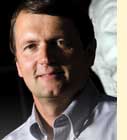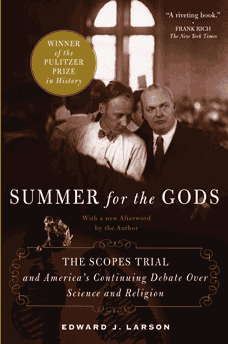Viewpoint
New Creationist Museum a
Window into Popular Belief
 Entering the main exhibition area, you’re greeted by an animated full-scale tyrannosaurus rex, and life-sized models of other dinosaurs inhabit the rooms ahead. It’s like visiting a natural history museum, but with one critical difference. Here, primitive humans appear alongside long-extinct species that predated us by more than 60 million years. One triceratops wears a saddle, and a pair of stegosauruses sails aboard Noah’s Ark. Interpretive signs, videos, and books tell viewers that everything presented here occurred within the past 10,000 years and that creation took just six 24-hour days, with humans and dinosaurs created together on the sixth day.
Entering the main exhibition area, you’re greeted by an animated full-scale tyrannosaurus rex, and life-sized models of other dinosaurs inhabit the rooms ahead. It’s like visiting a natural history museum, but with one critical difference. Here, primitive humans appear alongside long-extinct species that predated us by more than 60 million years. One triceratops wears a saddle, and a pair of stegosauruses sails aboard Noah’s Ark. Interpretive signs, videos, and books tell viewers that everything presented here occurred within the past 10,000 years and that creation took just six 24-hour days, with humans and dinosaurs created together on the sixth day.
All this and more—such as videos attributing a belief in evolution to racism, pornography, and abortion—await visitors to the new 60,000-square-foot, $27-million Creation Museum in Petersburg, Kentucky (near Cincinnati), which opened in May. Within two months, more than 100,000 paying visitors had toured this new shrine of so-called “young-earth creationism.” During my own private tour I was especially struck, as a historian who studies the legal controversy over creation and evolution, by this literal depiction of what countless modern creationists see in their mind’s eye when they envision the earth’s early history.
 People everywhere associate this sort of creationism with the American South. Tennessee’s 1925 Scopes Trial and its literary progeny, Inherit the Wind, stamped this image on the public consciousness. Kentucky’s new Creation Museum surely will help to perpetuate it. But this is not just a Southern phenomenon, as young-earth creationism has gone global. In Kenya, for example, local creationists have denounced the Leakeys’ famous fossils of early hominids as frauds and demanded their removal from the state museum. In Europe, the education ministers of Poland, Serbia, and Romania recently endorsed the teaching of creationism, with a Polish education official going so far as to call evolution “a lie.” It is illegal to teach evolution in many Islamic countries, and the Korean Association of Creation Research boasts thousands of members.
People everywhere associate this sort of creationism with the American South. Tennessee’s 1925 Scopes Trial and its literary progeny, Inherit the Wind, stamped this image on the public consciousness. Kentucky’s new Creation Museum surely will help to perpetuate it. But this is not just a Southern phenomenon, as young-earth creationism has gone global. In Kenya, for example, local creationists have denounced the Leakeys’ famous fossils of early hominids as frauds and demanded their removal from the state museum. In Europe, the education ministers of Poland, Serbia, and Romania recently endorsed the teaching of creationism, with a Polish education official going so far as to call evolution “a lie.” It is illegal to teach evolution in many Islamic countries, and the Korean Association of Creation Research boasts thousands of members.
Despite its references to age-old religious beliefs, this viewpoint so prominently on display at the Creation Museum is actually quite recent. For centuries, theologians and scientists had labored to reconcile advancing scientific thought with a meaningful interpretation of scripture. Just a century ago, even the most conservative American Protestants typically equated the day of creation in the Bible’s Genesis with ages of geologic time. In 1961, however, Henry Morris, a conservative Baptist on Virginia Tech’s engineering faculty, sought to revive the idea of a recent, six-day creation.
Young-earth creationism first spread among conservative American Protestants through the work of Morris’s Institute for Creation Research (ICR). Christian televangelists carried it worldwide. By the mid-1980s, numerous states and provinces in the United States, Canada, and Australia had mandated teaching creationism alongside evolution. Although American courts struck down such mandates, they have proliferated elsewhere. Young-earth creationism is now a staple in Christian schools around the globe—at schools on the Galapagos Islands, the fabled home of Darwinism, I found ICR texts being used to teach biology.
Public-opinion surveys suggest that up to half of adult Americans believe the basic tenets of young-earth creationism, even though it contradicts virtually everything we know about modern physics, astronomy, geology, and biology. Twenty percent of Western Europeans express similar views, as do over 30 percent of Brazilians.
I attribute the spread of creationism to the continuing appeal of religion. People aren’t persuaded by creationist arguments and then become religious. Rather, they seek meaning and community in religion and then conclude that young-earth creationism must follow. Meanwhile, popular science writers like Richard Dawkins, who argue that evolution proves atheism, reinforce this message. If forced to choose between God and evolution, most people will choose God.
The National Academy of Sciences maintains that people do not have to make such a stark choice. Indeed, although virtually every American biologist accepts the theory of evolution, many of them believe in God. In response to the rising popularity of creationism, some leading biologists who are also deeply religious have begun speaking out about their science and their faith. Recent bestsellers by Brown University biologist Kenneth Miller and Human Genome Project Director Francis Collins defend the theory of evolution from a Christian perspective. They know that evolutionary science is fundamental to research in medicine, genetics, and ecology, and they see no basic incompatibility with religious principles. Miller delivered this message at UGA’s prestigious Charter Lecture last fall, and it is high time that many more people heard it as well.
Contact Ed Larson at: edlarson@uga.edu
 |


